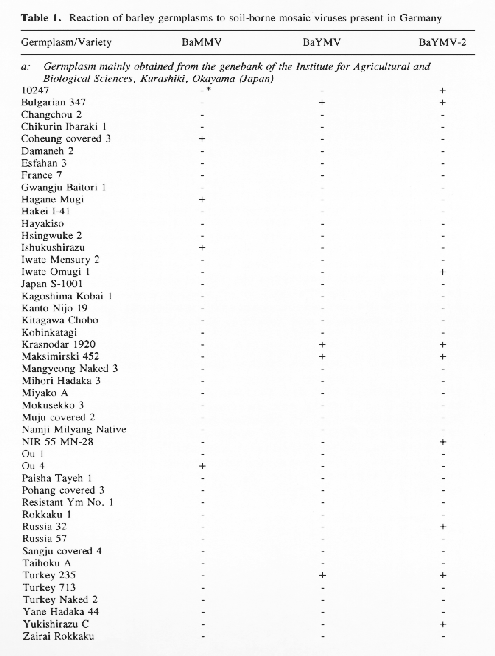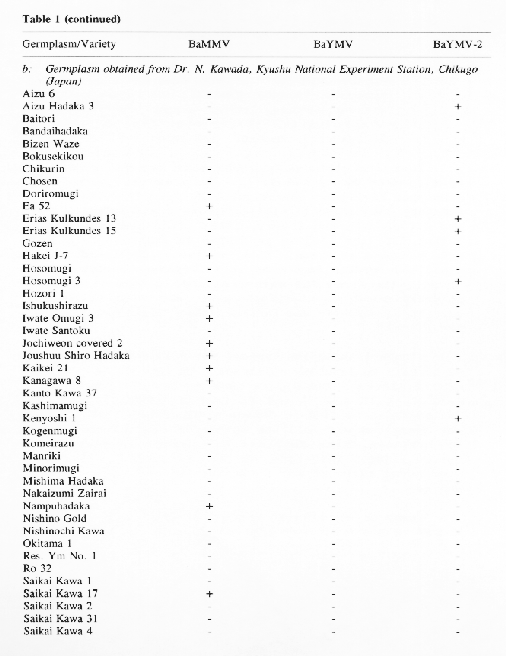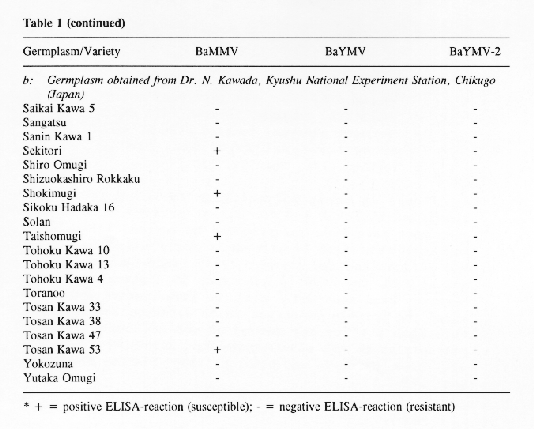

In Germany, barley yellow mosaic disease is caused by a complex of at least three viruses, i.e., barley mild mosaic virus (BaMMV), barley yellow mosaic virus (BaYMV) and BaYMV-2 (Huth & Adams, 1990; Huth, 1990). Resistance of German cultivars is presumed to be due to an identical recessive gene ('ym4') which is not effective against BaYMV-2, a virus strain first detected in 1988 (Huth, 1989). Germplasms obtained from the genebank of the Institute for Agricultural and Biological Sciences, Kurashiki, Okayama (Japan), and from Dr. N. Kawada, Kyushu National Experiment Station, Chikugo (Japan), were screened for reaction to the different pathogens of barley yellow mosaic disease, in order to identify varieties resistant to BaYMV-2. The germplasms screened had earlier been tested for their reaction to Japanese strains of BaYMV (Takahashi, 1983; Kawada, 1991).
Screening for BaYMV-2 resistance was carried out on an infested field in Schladen (Lower-Saxony) and for BaMMV/BaYMV-resistance on an infested field in Belhausen/Gilserberg (Northern Hesse). Furthermore, the varieties were tested for BaMMVresistance by mechanical inoculation in the greenhouse. Reactions of the germplasms to the different viruses were investigated by DAS-ELISA using BaMMV/BaYMV-specific antisera kindly provided by Dr. W. Huth, Braunschweig. Due to the fact that no BaYMV-2 specific antiserum is available up to now, this virus can be detected with certainty in BaYMV-resistant germplasms only, because of serological cross reaction with BaYMV. The results obtained with BaMMV by field infection in Bellnhausen were the same as those obtained by mechanical inoculation in the greenhouse and are not listed separately, therefore.
Most of the germplasms tested were resistant to all of the soil-borne mosaic-inducing viruses known in Germany (Table. 1). Others, like 'Krasnodar 1920' and 'Maksimirski 452' were resistant to BaMMV only, while some germplasms (e.g. 'Ea 52') showed resistance to BaYMV and BaYMV-2 but susceptibility to BaMMV. A fourth group reacted like resistant German cultivars, i.e., resistant to BaMMV and BaYMV but susceptible to BaYMV-2. The results obtained indicate that there is a complex situation not only with regard to the virus but also regarding varietal reaction to the yellow mosaic inducing viruses. However, resistance to BaYMV-2 - the resistance breaking strain of BaYMV - seems to be present in a large number of foreign barley germplasms, especially in those deriving from East-Asia. These germplasms are a useful source for incorporating BaYMV-2 resistance into adapted high-yielding cultivars. Furthermore., some of these varieties, like Tikurin lbaraki I' and 'Taihoku A', carry BaMMV resistance genes different from 'ym4' (Götz & Friedt, 1993) and different from each other (Ordon & Friedt, 1993). Therefore, these varieties are best suited for incorporating resistance to BaYMV-2 by simultaneously broadening the genetic base of BaMMV resistance. This may prevent the selection of new BaMMV strains as has already been reported from Japan (Kashiwazaki et al., 1990).



Acknowledgements
The authors wish to thank Dr. T. Konishi, Institute of Genetic Resources, Faculty of Agriculture, Kyushu University, Fukuoka (Japan) and Dr. N. Kawada, Kyushu National Experiment Station, Chikugo (Japan) for providing seeds. Thanks are also due to Dr. W. Huth, Federal Biological Research Center, Braunschweig, Germany, for providing ELISA antisera.
References
Götz, R., and W. Friedt. 1993. Resistance to the barley yellow mosaic virus complex - Differential genotypic reactions and genetics of BaMMV-resistance of barley (Hordeum vulgare L.). Plant Breed. I 11: 125-13 1.
Huth, W. 1989. Ein weiterer Stamm des Barley yellow mosaic virus (BaYMV) gefunden. Nachrichtenbl. Deut. Ptlanzenschutzd. 41: 6-7.
Huth, W. 1990. The yellow mosaic inducing viruses of barley in Germany. Proc. lst Symp. Int. Working Group Plant Viruses with Fungal Vectors, Braunschweig, Germany, 113115.
Huth, W., and M.J. Adams. 1990. Barley yellow mosaiv virus (BaYMV) and BaYMV-M: two different viruses. Intervirology 31: 38-42.
Kashiwazaki, S., K. Nomura, K. Watanabe, 1. Toshima, Y. lida, T. Usugi, K. Ogawa, H. Hibino, and T. Tsuchizaki. 1990. Barley yellow mosaic virus and barley mild mosaic virus: strains and host resistance. Proc. Ist Symp. Int. Working Group Plant Viruses with Fun al Vectors, Braunschweig, Germany, 105-108.
Kawada, N. 1991. Resistant cultivars and genetic ancestry of the resistance genes to barley yellow mosaic virus in barley (Hordeum vulgare L.). Bull. Kyushu Nat. Exp. St. 27: 65-79.
Ordon, F., and W. Friedt. 1993. Mode of inheritance and genetic diversity of BaMMV resistance of exotic barley germplasms carrying genes different from 'ym4'. Theor. Appl. Genet. 86: 229-233.
Takahashi, R. 1983. Catalogue of barley germplasm preserved in Okayama University. Inst. Agr. Biol. Sci., Okayama Univ., Kurashiki, Japan. 217p.